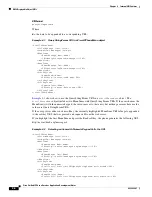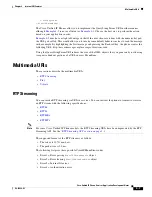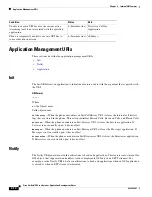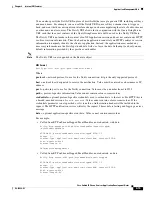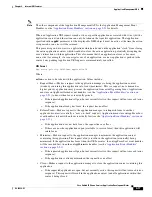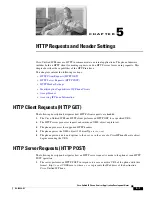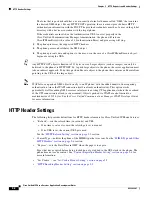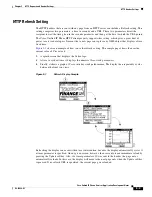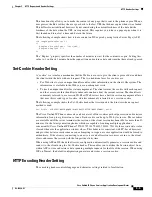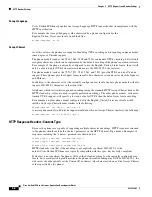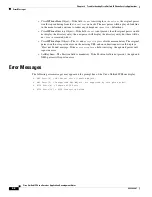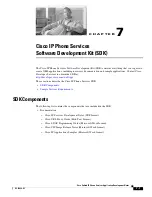
5-2
Cisco Unified IP Phone Services Application Development Notes
OL-18696-01
Chapter 5 HTTP Requests and Header Settings
HTTP Header Settings
The form that is posted should have a case-sensitive form field name called “XML” that contains
the desired XML object. For any HTTP POST operation, the server must provide basic HTTP
authentication information with the POST. The provided credentials must be of a user in the global
directory with a device association with the target phone.
If the credentials are invalid, or the Authentication URL is not set properly in the
Cisco Unified Communications Manager Administration, the phone will return a
CiscoIPPhoneError with a value of 4 (Authentication Error) and processing will stop.
2.
The phone processes the supported HTTP headers
3.
The phone parses and validates the XML object
4.
The phone presents data and options to the user, or in the case of a CiscoIPPhoneExecute object,
begins executing the URIs.
Tip
Any HTTP POST object is limited to 512 bytes in size. Larger objects (such as images) can only be
delivered to the phone via HTTP GET. So, to push large objects to the phone, the server application must
take an indirect approach. To do this, push an Execute object to the phone that contains an ExecuteItem
pointing to the URL of the large object.
Note
JTAPI also can push an XML object directly to an IP phone, with the added benefit of not requiring
authentication (since the JTAPI connection itself is already authenticated). This option works
particularly well for adding XML services interfaces to existing CTI applications (where the overhead
of the CTI connection is already a requirement). Objects pushed via JTAPI are also limited to a
maximum size of 512 bytes. See the
Cisco Unified Communications Manager JTAPI Developer Guide
for more information.
HTTP Header Settings
The following list provides definitions for HTTP header elements for Cisco Unified IP Phone Services:
•
“Refresh”—sets the refresh time (in seconds) and URL
–
If no time is set or it is zero, the refresh gets set to manual.
–
If no URL is set, the current URL gets used.
See the
“HTTP Refresh Setting” section on page 5-3
section.
•
ContentType —notifies the phone of the MIME type that was sent. See the
“MIME Type and Other
HTTP Headers” section on page 5-4
section.
•
“Expires”—sets the Date/Time in GMT when the page is to expire.
Pages that have expired before being loaded do not get added to the URL stack in the phone. The
phone does not cache content. See
“Content Expiration Header Setting” section on page 5-4
for
more information.
•
“Set Cookie” - see
“Set-Cookie Header Setting” section on page 5-5
•
“HTTP Encoding Header Setting” section on page 5-5

